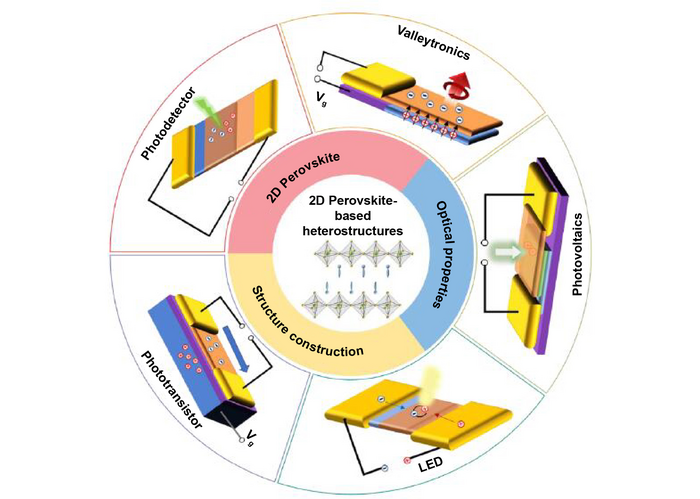Van der Waals heterostructures made of different two-dimensional (2D) layered materials serve as fundamental building blocks for optoelectronic devices with novel functionalities like photovoltaic solar cells, light emitting diodes (LEDs), and photodetectors.

In this article, the structure and physical properties of 2D perovskites will be first highlighted. The construction and characterizations of 2D perovskite-based heterostructures as well as the basic optical properties of the constructed heterostructures will then be illustrated. Furthermore, the potential applications of 2D perovskite-based heterostructures in photovoltaic devices, light-emitting diodes, photodetectors, phototransistors, and valleytronic devices will be demonstrated. Finally, the current challenges and propose further research directions in the field of 2D perovskite-based heterostructures will be discussed. Image Credit: Haizhen Wang, Yingying Chen, and Dehui Li.
Two-dimensional and quasi-two-dimensional perovskites, in particular, exhibit unique properties such as high exciton binding energy, high photoluminescence quantum efficiency, large oscillator strengths, and long carrier diffusion length, and are thus emerging candidates for next-generation optoelectronic devices.
Heterostructures integrating distinct layered 2D perovskites with other layered or non-layered materials can introduce novel optical and optoelectronic properties, vastly expanding the heterostructures’ potential functionalities and applications.
The group, guided by Huazhong University of Science and Technology researchers, compiled recent developments of 2D/quasi-2D perovskite-based heterostructures to enable the discovery of unexplored phenomena and open up a new range of optoelectronic applications in the journal IJEM.
The group discussed the construction and characterization of 2D/quasi-2D perovskite-based heterostructures, as well as the notable optical properties of the constructed heterostructures, after introducing the structure and physical properties of 2D/quasi-2D perovskites.
Furthermore, 2D/quasi-2D perovskite-based heterostructures were shown to have possible applications in photovoltaic devices, light-emitting devices, photodetectors/phototransistors, and valleytronic devices. The challenges and future prospects of 2D perovskite-based heterostructures were also discussed.
The rich electronic and optical physics offered by 2D perovskites renders them to be very promising for optoelectronic applications. The electronic structure of 2D perovskites can be efficiently modulated by changing the layer number n value, substituting halide anions and incorporating organic chains, which further modifies their optical performances, bringing both advantages and disadvantages for optoelectronic applications.
Dehui Li, Lead Researcher and Professor, Huazhong University of Science and Technology
Dehui Li, “However, the synthesis of pure phase quasi-2D perovskites and heterostructures on a large scale in a controllable manner is still lacking. In this review, we summarized all developed methods to prepare 2D perovskite and heterostructures, which would be helpful to explore new strategies for material preparation.”
The basis for optoelectronic device architectures and applications is laid by heterostructure construction. Dry transfer, solution synthesis, and vapor deposition are some of the techniques used to create 2D perovskite heterostructures. Furthermore, optical spectra, phase identification, and surface morphology characterization are common methods for characterizing heterostructures.
Optical property is one fascinating functional aspect of 2D perovskite-based heterostructures, which not only inherit the basic physical properties of 2D perovskites but also show rich new photophysics that does not exhibit in each constituent material.
Dr. Haizhen Wang, Study Co-First Author, Huazhong University of Science and Technology
As a result, 2D perovskite-based heterostructures are an excellent platform for studying charge/energy transfer processes, ion migration-induced optical properties, and nonlinear optical effects. Nonetheless, research on those topics is still in its early stages, and more research is needed.
2D perovskites can be stacked with other materials to establish heterostructures with different band alignments, which can be type I or type II based on different constituents in heterostructures leading to different optoelectronic applications.
Yingying Chen, Study Co-First Author and Ph.D. Student, Huazhong University of Science and Technology
This review sorted and debated performance in photovoltaic devices, photodetectors, light-emitting devices, phototransistors, and valleytronic devices based on various 2D perovskite heterostructures.
Prof. Dehui Li notes, “The excellent optical and optoelectronic properties of 2D perovskite-based heterostructures have led to a wide range of applications in optics and optoelectronics. However, many problems are still encountered at this stage, which include the rational synthesizing pure phase 2D perovskites and their heterostructures on large scale in a controllable manner, deeply understanding their fundamental physical properties as well as fully exploring their potential novel optoelectronic applications.”
Prof. Dehui Li concludes, “We believe that more 2D perovskite-based heterostructures with novel functionalities will be constructed taking advantage of the great flexibility in composition, structure, and properties of 2D perovskites.”
Journal Reference
Wang H., et al. (2023) Two/Quasi-two-dimensional perovskite-based heterostructures: construction, properties and applications. International Journal of Extreme Manufacturing. doi.org/10.1088/2631-7990/acab40.